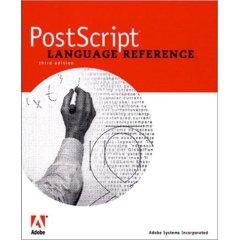| 2020ok Directory of FREE Online Books and FREE eBooks |
Free eBooks > Computers & Internet > Graphics & Illustration > Applications > Adobe > PostScript > PostScript Language Reference,3rd Edition [The Red Book]
PostScript Language Reference,3rd Edition [The Red Book]by Adobe Systems Inc.  Download Book (Respecting the intellectual property of others is utmost important to us, we make every effort to make sure we only link to legitimate sites, such as those sites owned by authors and publishers. If you have any questions about these links, please contact us.) link 1 link 2 About Book Amazon.com Programmers who specialize in PostScript, the page-description language, now have a newly updated reference guide for LanguageLevel 3. PostScript® Language Reference starts off with a bit of history on the language and an overview of the new version. It goes on to cover basic topics such as raster output devices, scan conversion, and page-description languages in general. PostScript® Language Reference provides an overview of how to use the PostScript interpreter and understand the ideal structure of PostScript page descriptions. The book covers the heart of the language, including syntax, data types and objects, stacks, execution, basic operators, memory management, file input/output (I/O), functions, errors, and filtered-files and binary-encoding details. Subsequent chapters cover graphics, fonts, device control, rendering, and operators. The appendices include a LanguageLevel feature summary, implementation limits, interpreter parameters, compatibility issues, character sets, encoding vectors, system-name encodings, and operator-usage guidelines. There's also a bibliography with additional reading recommendations. --Kathleen Caster
The PostScript language is widely recognized as the industry standard for page description. Incorporated into a broad range of printers, imagesetters, and computer displays, PostScript describes exactly how text, sampled images, and graphics will appear on a printed page or on a computer screen. The PostScript Language Reference, known as the Red Book, is the complete and authoritative reference manual for the PostScript language. Prepared by Adobe Systems Incorporated, the creators and stewards of the PostScript standard, it documents the syntax and semantics of the language, the Adobe imaging model, and the effects of the graphics operators. This Third Edition has been updated to include LanguageLevel 3 extensions, which unify a number of previous extensions and introduce many new features, such as high-fidelity color, support for masked images, and smooth shading capabilities. Book Highlights:
The enclosed CD-ROM contains the entire text of this book in Portable Document Format (PDF). The Red Book is the definitive resource for all PostScript programmers. 0201379228B04062001 About the Author Adobe Systems Incorporated, founded in 1982, is a leading provider of graphic design, publishing, and imaging software for Web and print production, and the second-largest desktop software company in the world. The company builds award-winning software solutions for Web and graphic designers, professional publishers, document-intensive organizations, business users, and consumers. 0201379228AB09252001 Excerpted from Postscript Language Reference, aka The Red Book by Adobe Systems Incorporated and Adobe Systems. Copyright © 1999. Reprinted by permission. All rights reserved Preface In the 1980s, Adobe devised a powerful graphics imaging model that over time has formed the basis for the Adobe PostScript technologies. These technologies--a combination of the PostScript language and PostScript language-based graphics and text-formatting applications, drivers, and imaging systems--have forever changed the printing and publishing world by sparking the desktop and digital publishing revolutions. Since their inception, PostScript technologies have enabled unprecedented control of the look and feel of printed documents and have changed the overall process for designing and printing them as well. The capabilities PostScript makes possible have established it as the industry page description language standard. Today, as never before, application developers and imaging systems vendors support the PostScript language as the industry standard. We at Adobe accept our responsibility as stewards of this standard to continually advance the standard in response to the creative needs of the industry. With this third advance of the language, which we call LanguageLevel3, Adobe has greatly expanded the boundaries of imaging capabilities made possible through the PostScript language. This most recent advance has yielded significant improvements in the efficiency and performance of the language as well as in the quality of final output. To complement the strengths of Language Level 3, Adobe PostScript 3imaging system technologies have been engineered to exploit the new Language Level 3 constructs to the fullest extent, fulfilling the Adobe commitment to provide printing solutions for the broad spectrum of users. No significant change comes without the concerted effort of many individuals. The work to advance the PostScript language and to create Adobe PostScript 3 imaging system technologies is no exception. Our goal since the introduction of the first Adobe imaging model has been nothing less than to provide the most innovative, meaningful imaging solutions in the industry. Dedicated Adobe employees and many industry partners have striven to make that goal a reality. We take this opportunity to thank all those who contributed to this effort. John Warnock and Chuck Geschke January 1999 Related Free eBooks
| Related Tags |












SEND A COMMENT
PLEASE READ: All comments must be approved before appearing in the thread; time and space constraints prevent all comments from appearing. We will only approve comments that are directly related to the article, use appropriate language and are not attacking the comments of others.